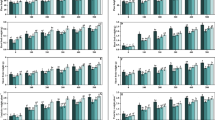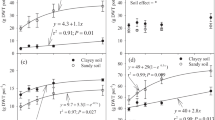Abstract
Rice plants with bronzing, collected from fields in central and southern Nigeria, where the soils consisted of Tropaquent, Tropaquult and Tropaquept, showed higher iron and lower potassium, phosphorus, and magnesium concentrations than plants with little or no bronzing. Pot experiments with the soils indicated that the severity of the bronzing was affected not only by the iron concentration in the shoots but also by the potassium concentration. The application of chloride compounds to the soil increased severity of the bronzing and lead to deterioration of growth, whereas the application of sulfate compounds was beneficial.
The application of potassium sulfate reduced the severity of bronzing and increased the dry matter production of rice plants grown in the field. The concentration and accumulation of potassium in the shoots increased when the bronzing severity decreased and the iron concentration was decreased by the dilution effect caused by the increased dry matter production.
Similar content being viewed by others
References
Baba I, Inada K and Tajima K 1964 Mineral nutrition and the occurrence of physiological diseases.In The Mineral Nutrition of the Rice Plants. Proceedings of a symposium at the International Rice Research Institute. pp 173–195. The Johns Hopkins Press, Baltimore, Maryland, USA.
Inada K 1965a Studies on bronzing disease of rice plant in Ceylon. I. Effect of field treatments on bronzing occurrence, and change in leaf respiration induced by the disease. Proceedings of the crop Science Society of Japan, 33, 309–314.
Inada K 1965b Studies on bronzing disease of rice plant in Ceylon. 2. Cause of the occurrence of bronzing. Proceedings of the Crop Science Society of Japan, 33, 315–323.
IITA 1982 Automated and semi-automated methods for soil and plant analysis. Manual Series No. 7. IITA, Ibadan, Nigeria.
IITA 1983 Annual Report for 1982, IITA, Ibadan, Nigeria.
IITA 1984 Annual Report for 1983. IITA, Ibadan, Nigeria.
International Rice Testing Program 1980 Standard Evaluation System for Rice. International Rice Research Institute, Los Baños, Philippines.
Kosaki T and Juo ASR 1986 Iron toxicity of rice in inland valleys: a case from Nigeria.In The Wetlands and Rice in Subsaharan Africa. Eds. ASR Juo and JA Lowe. pp 167–174. IITA, Ibadan, Nigeria.
Ota Y and Yamada N 1962 Physiological study on bronzing of rice plant in Ceylon (Preliminary report). Proceedings of the Crop Science Society of Japan 31, 90–97.
Ponnamperuma FN 1972 The chemistry of submerged soils. Adv. Agron. 24, 29–96.
Ponnamperuma FN, Bradfield R and Reech M 1955 Physiological disease of rice attributable to iron toxicity. Nature 175, 265.
Tadano T 1979 Studies on the iron nutrition of rice plants. Part 4. Excess iron absorption as affected by nutritional status of the plant. J. Sci. Soil. Manure, Japan 41, 498–501.
Tadano T and Tanaka A 1970 Studies on the iron nutrition of rice plants. Part 3. Iron absorption affected by potassium status of the plant. J. Sci. Soil. Manure, Japan 41, 142–148.
Takijima Y and Kanaganayagam N 1970 Nutrient definiency and physiological disease of lowland rice in Ceylon. IV. Remedy for bronzing disease of rice. Soil Sci. Plant Nutr. 16, 17–23.
Tanaka A, Loe R and Navasero SA 1966 Some mechanisms involved in the development of iron toxicity symptoms in the rice plant. Soil Sci. Plant Nutr. 12, 32–38.
Tanaka A, Nulleriyawa RP and Yasu T 1968 Possibility of hydrogen sulfide induced iron toxicity of the rice plant. Soil Sci. Plant Nutr. 14, 1–6.
Tanaka A and Yoshida S 1970 Nutritional disorder of the rice plant in Asia. International Rice Research Institute Technical Bulletin 10. International Rice Research Institute, Los Baños, Philippines, 51 p.
Trolldenier G 1977 Mineral nutrition and reduction processes in the rhizosphere of rice. Plant and Soil 47, 193–202.
Van Breemen N and Moormann FR 1978 Iron-toxic soils.In Soils and Rice. pp 781–800. International Rice Research Institute. Los Baños, Philippines.
Yamada N 1959 Some aspects of the physiology of bronzing. International Rice Commission Newsletter 8, 11–16.
Yamanouchi M and Nagai T 1985 The effect of chloride and sulfate ion on the iron absorption and its translocation of rice plants with a high iron nutrient solution. Jap. J. Soil. Sci. Plant Nutr. 56, 433–439.
Author information
Authors and Affiliations
Rights and permissions
About this article
Cite this article
Yamauchi, M. Rice bronzing in Nigeria caused by nutrient imbalances and its control by potassium sulfate application. Plant Soil 117, 275–286 (1989). https://doi.org/10.1007/BF02220722
Received:
Revised:
Issue Date:
DOI: https://doi.org/10.1007/BF02220722




